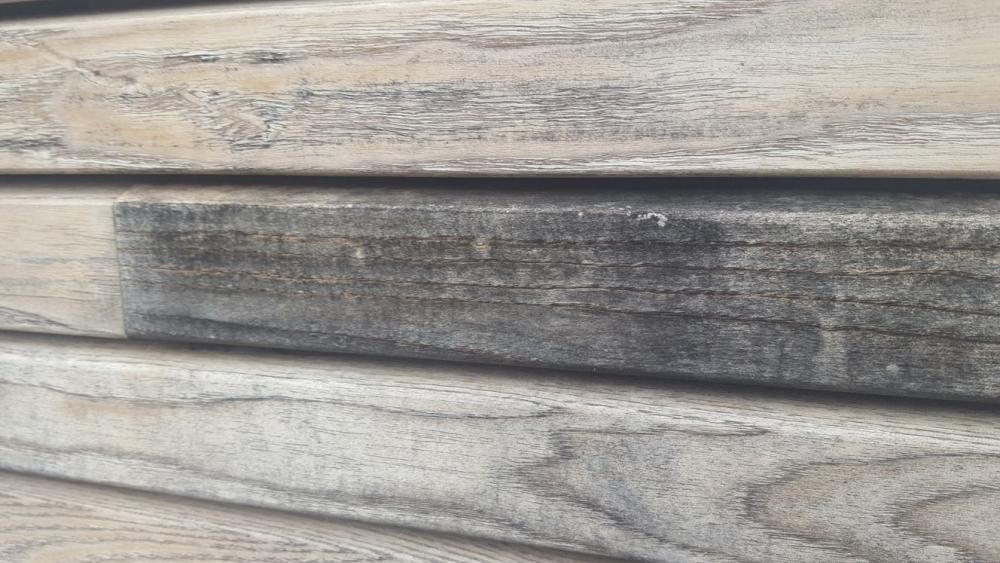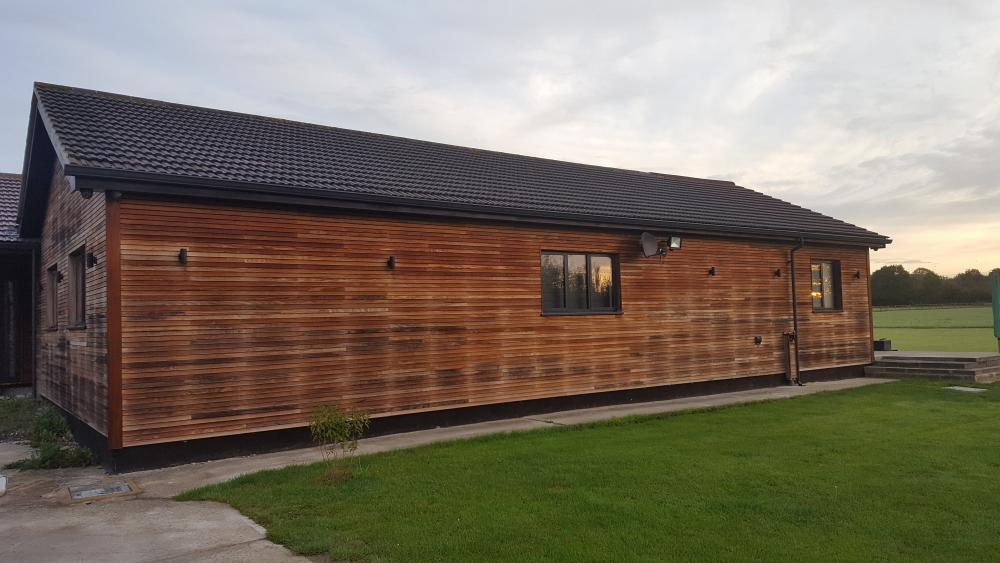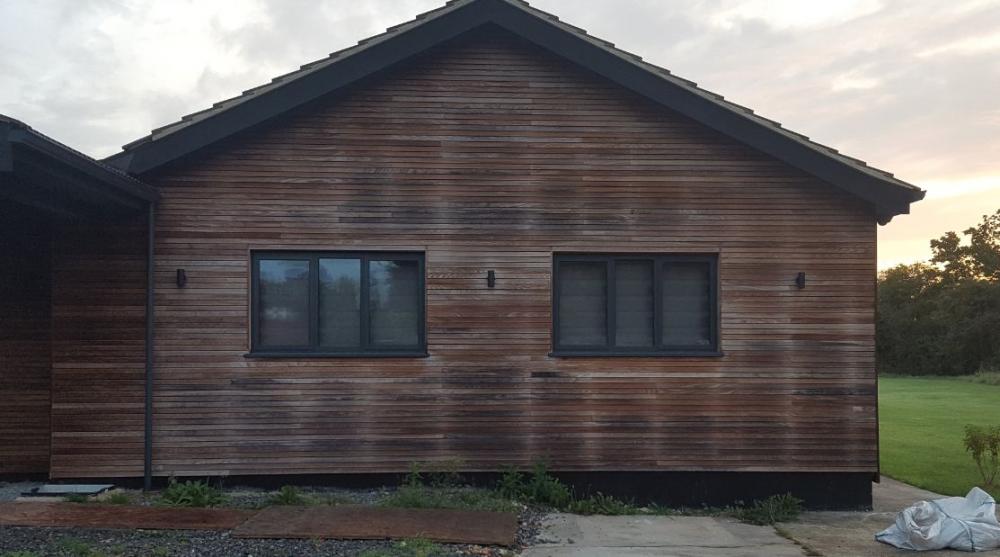
Dean Carpenter
Members-
Posts
9 -
Joined
-
Last visited
Recent Profile Visitors
The recent visitors block is disabled and is not being shown to other users.
Dean Carpenter's Achievements

New Member (2/5)
2
Reputation
-
Problems with hotwood cladding
Dean Carpenter replied to Dean Carpenter's topic in Building Materials
I thought I'd update this thread: Cleaning with a water, light detergent and a brush not only took forever but it was pretty patchy too. Like painting the Golden gate Bridge - before I finished the bit I had started had already deteriorated. I didn't want to jet-wash as I was advised against it as it would apparently roughen the surface and further help the dreaded mould to grow even more. After talking to a few providers of commercial cleaning products that would have cost me many hundreds of pounds to buy let alone the labour to apply, one of the technical people was very honest with me and recommended I try soaking the surface with clean water then using a weak bleach/water mixture 1/10 applied with a fine spray nozzle. At first this looked promising but the mix was drying-out before it had time to work properly. I increased the mixture incrementally to about 1/4 and this worked really well. IMPORTANT to do this at a time of the year when it's still quite damp outside and cloudy i.e. so that the mixture will not evaporate too fast thereby giving it time to work. It's very important to thoroughly soak the surface with clean water, starting high up and I did arreas about 3m2 at a time. I applied the mixture to a really wet surface so that on contact the mould can run down easier. Leave it for about 20 mins max then wash with clean water. After looping the whole house once some stains were apparent where the mould had run. A second application of the whole house cleaned that up. After about 2 weeks the cladding had turned to near white, like drift-wood. At first I was worried but since I did this very early spring it's now weathered back to a kind of grey. I wanted to leave it for 1 summer and 1 winter to see what happened There are no apparent signs that the bleaching has damaged the wood The surface is a kind of grey but not grey enough for my liking Right now the mould is showing signs of coming back but nothing like the images above My next step is to repeat the cleaning process in a few weeks time but this time it should be easier as the cladding is nowhere near as bad as it was. In the summer I'm going to treat it with Textrol. This was apparently used on the London Velodrome so if it's good enough for them it should be good enough for me. Not cheap though at approx £1,500 materials only for my job -
Problems with hotwood cladding
Dean Carpenter replied to Dean Carpenter's topic in Building Materials
Hi to all: unfortunately it was paid by bank transfer. I do have some left over that I kept for repairs as/when needed. It's been up for about 1.5 years. -
Problems with hotwood cladding
Dean Carpenter replied to Dean Carpenter's topic in Building Materials
here's a close-up image, which indicates to me the problem is specific to the board as you can clearly see one board worse than the other -
Problems with hotwood cladding
Dean Carpenter replied to Dean Carpenter's topic in Building Materials
The image shows the west elevation but the worst is the south elevation (to the right of the image). It's a problem 360 deg around the house. see below image of south elevation. This was taken a while ago. It's now a whole load worse -
Problems with hotwood cladding
Dean Carpenter replied to Dean Carpenter's topic in Building Materials
The sioox product looks like it could be a solution: thanks for this advice. I will give that a try. In my opinion the issue is product related because you can clearly see abutting sections where one is bad and the other is not so bad: I hesitate to say good The wall section is mostly concrete block-work of various types (I inherited most of the walls and the main construction was built over a 50 year period) . This was wrapped in Tyvek UV (black, doubly expensive) with all joints and openings tape sealed in a special Tyvek Uv tape (extra, extra expensive! and well over 1 week work just for the taping). The battens are fixed approx 600mm centres. the battens were supplied by Carpentier. I believe they are treated the same as the product itself but that shouldn't matter because the clips on the battens are plastic anyway: no moisture can transfer from batten to cladding. The cladding is a 29mm deep rhombus shape approx 50-60mm high with approx a 10mm air gap in between. I used the same material on my front gate but with less spacing. When installed the effect was stunning. The claim they make about it not splitting, shrinking is also false but this was not a big problem for me. It's the blackening that's really peeved me Carpentier really let themselves down as I had recommended the product to many people but since sent them all warnings for obvious reasons. -
Problems with hotwood cladding
Dean Carpenter replied to Dean Carpenter's topic in Building Materials
Thanks for all of your replies. I must have a type of wood cladding as a condition of the planning permission (this is a conversion from commercial to domestic). Originally they wanted black painted weatherboard (to make it look like a barn) but I managed to convince them to go for something more contemporary (bad move on my part as it turns out) so if I changed the cladding I would likely have to go back to the planners for another material amendment; not ideal. Then there is the cost/work involved to replace, which would be horrendous and circa £50k The manufacturer rep is actually a really nice guy and I do believe him when he says they have many trouble free installations but this is a case where clearly it's going to be more challenging and he/they simply are not prepared to take any responsibility. To quote "I don’t know anymore what to say." and "For 100% sure it is not the product to blame" I've built a few houses and it's par for the course to encounter problems but most are resolvable; this one is a painfully large problem. to Ferdinand: petitions/pseudo-blackmail or whatever else it is called can work but is not without consequence. On the same project I bought near £20k of Garafoli (Italy) internal doors and some of them were really poorly installed. Pressing the UK rep got me nowhere, Garafoli batted me back to the so I gave them the Internet reviews they deserved and since then all I get is threats to sue me. I say go ahead as you can't be punished for telling the truth. This case was a real shame as the doors were beautiful but the rep (Moore & Moore) was terrible to deal with One thing I have learned from both of these bad experiences: buy British. -
Problems with hotwood cladding
Dean Carpenter replied to Dean Carpenter's topic in Building Materials
This is an image showing the problem. Doesn't look like the images on their web site, does it? Also, in some areas there is growth but to specific strips of wood only, which logically tells me that some of the wood is resistant and some is not -
Problems with hotwood cladding
Dean Carpenter replied to Dean Carpenter's topic in Building Materials
Oz07: 315m2 JS Harris: many thanks. I bought the product from the manufacturer. Onoff: The company in your link is the company/product I purchased. I was told it would grey to a beautiful patina over time and not require painting, etc. In fact it's gone blotchy black in places, stayed brown in others and where the battens are it's lighter. First I was told I had not used the correct construction: I have - I sent them a cross-section of the wall design, which easily proves this. Then I was told I have not left enough clearance at the bottom (300mm) but firstly their site shows images of cladding to the floor and secondly on the worst elevations I have a 400mm ground clearance. To clean 315m2 of this stuff would take a week or more and cost a small fortune. This is one quote I have before I bought it : "we use it for all kind of projects where people would use either aluminium ,because they don’t dare to work with wood." Here's another I had once I sent images of the problem "I have never seen anything like the pictures you show me." I seriously regret installing this product. -
At significant expense (£34k just for materials) I have installed a product called Thermoash otherwise known as Hotwood; it's ash that has been treated under pressure to give it Class 1 durability. The product is sold as being virtually indestructible (maintenance free, resistant to rot, cracking, warping, etc). It's basically a form of real wood rainscreen. It sits on plastic clips fixed to battens 25mm from the building wall surface (the building is wrapped in a special version of Tyvek) and it is supposed to add to the thermal efficiency, etc, of the building. After a year since installation I'm seeing mould appear on it and also a difference between the battens. The manufacturer (Carpentier from Belgium) blamed me saying the installation was incorrect but that's simply not the case and after I showed them the installation was good they since refused to accept any responsibility. Then they told me to clean it regularly; what happened to 'maintenance free' ? I'm now left with a horrible looking rain screen. Does anyone have any experience with this problem and how to fix it?




